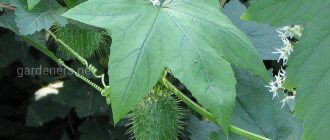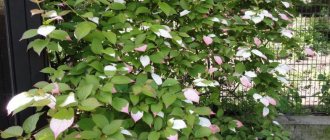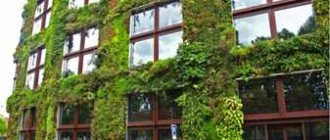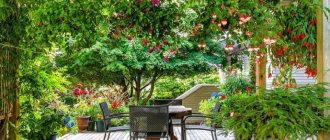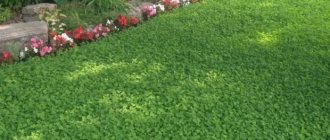- home
- Articles
- Planting material
- Plants for vertical gardening
A modern way to design a site is vertical gardening.
The essence of this method is that vertical supports (walls or other specialized structures) are covered with green mass. In this case, the decorative properties of plants are actively used: the color of their foliage, the presence of lush flowers, bright fruits, etc. Another feature of the breeds used for these purposes is their rapid growth. Therefore, it is possible to achieve powerful decorative effects in a relatively short time. Another serious advantage of this method is the ability to create the effect of voluminous plant masses in small areas. Large spaces visually give the feeling that you are completely surrounded by plantings, while the actual depth of the green wall is very small.
Type of base and choice of planting material for vertical gardening
There are several reasons on the basis of which landscape designers decide on the choice of plants for vertical foundations. First of all, this is the type of architectural form that will be landscaped. Each structure is characterized by its own surface texture, the presence or absence of gaps, and height. For example, brick and stone are rough; plants that have suckers or adventitious roots attach well to them. These are various varieties of ivy, virgin grapes and rooting campsis.
Smooth surfaces will require special support structures on which climbing species will be mounted. There are those that wrap their stems around them. These are honeysuckle and kirkazon. Others, such as clematis, cling to them with leaf petioles. And grapes that have tendrils are able to attach themselves due to them. If you want to use plants for vertical gardening that are not able to be fixed to supports on their own, then you need to be prepared to tie them up. The trees are harmoniously decorated with hydrangea, clematis, honeysuckle, and grapes. Arches and pergolas are decorated with clematis, wisteria, and nightshade. And tripods can be used as a support for ivy, hops, and wood pliers.
Classification of plants according to the methods of their attachment to supports:
- Crops that do not require any additional structures for fastening, as they take root on the walls. Camasas, virgin grapes, ivy, euonymus, petiolate hydrangea, fortunea feel great on the rough surfaces of any buildings (houses, fences, barns, etc.);
- Vines that are attached to supports by leaf petioles or tendrils. Naturally, with this type of fastening, thin elements are needed, around which a delicate tendril or leaf can curl. With tendrils located at the tips of new shoots, clematis, china, pumpkin, kobeya, passionflower, and echinocystis cling to thin stretched threads. It is interesting that after the vine catches on the thread, the tendril wrapped around the support loses its plasticity and becomes lignified. Leafy petioles wrap around supports in species such as clematis, nasturtium, and prince.
- Plants that rest on trellises, trellises, trellises and thus climb up. Thorns and thorns often help in this process. These are bare-flowered jasmine, blackberry, and climbing rose.
- Climbing species that clasp the support with the entire shoot. Depending on their genetic characteristics, they can twine either only around fairly thin branches, or even around thick tree trunks. The growth rate of all crops is also different. The most common in this group are hops, morning glory, ornamental beans, clerodendron, Chinese lemongrass, wisteria, wood pliers, and kirkazon.
Advantages and disadvantages
Vertical flower beds have their pros and cons. The latter are solvable and not so critical as to give up the idea of using original, fresh solutions in landscape design.
Advantages:
- saving space. Arranging pots or boxes one above the other allows you to place a large number of plants in a relatively small area;
- the proximity of crops that in the open ground interfere with each other or “are at enmity.” It's no secret that not all plants can be planted nearby. A completely natural struggle for minerals and water arises when the fittest survives. Vertical solves such problems;
- in pots or other containers planted with flowers, practically no weeds grow (especially if the soil has been prepared in advance), there are no pests;
- originality of construction and individual design will make the site different from others.
Flaws:
- a small volume of soil requires regular fertilizing;
- outside, the soil in pots dries out quickly, there is no groundwater, so frequent watering of the plants is required to maintain the beauty of the greenery and flowering;
- In winter, the roots of perennials left outside freeze very much. It is recommended to make the structure collapsible (containers with flowers are removable) in order to put them in the basement or cellar during the cold period.
Selecting plants according to their climatic requirements
The choice of plants for vertical gardening is influenced by the location of the supporting walls: light-loving crops that are drought-resistant will feel good on the south side, while shade-loving crops that require moist soil will feel more comfortable on the north side.
Thus, according to the experience of the staff, jasmine, cotoneaster, virgin grapes, forsythia, and ivy feel good in the north. On southern surfaces there are rhododendrons, honeysuckle, clematis, roses, magnolias. In the east you can plant hydrangea, quince, garria, wood-lovers, and in the west - nightshade, ropewort, camellia and broom.
Clematis is universal in this regard: it tolerates both frosts of minus thirty and extreme heat. However, each plant has its own subtleties during cultivation. For example, there are those who do not tolerate drafts and cold winds well. An example is girlish grapes. A special feature of clematis is the need to shade it at the roots. This selective shade-loving behavior is a consequence of its origin, because historically it is a forest species. It is enough to plant a low shrub near a green wall with clematis, and the plant will feel great.
It is worth noting that each species has varieties of varying degrees of unpretentiousness. Typically, hybrids are more delicate and sensitive to cold and heat, although their decorative effect can be more pronounced.
Landscape ideas
Vertical landscaping is recognized as an important component of gardens and home areas with small areas. In our region, vertical structures are decorated with vines, variants of hanging or climbing plants. Thanks to their diversity, territories, gardens and buildings acquire a uniquely attractive appearance. When landscaping a garden, they often use flat supporting devices, rectangular, fan-shaped or semicircular in configuration. The goals of landscaping determine the possibility of using screens, screens, and trellises. Screens are most often used to highlight and isolate garden space.
The use of diverse structures and devices makes it possible to create unique natural images that can transform the surrounding space and vertical surfaces. It is worth understanding the phenomenon and the principles of its application.
Tasks
The main tasks facing landscape design masters involved in vertical gardening of houses and plots include:
- organization of zoning of the garden area from the standpoint of aesthetics and comfort;
- creating living protection from direct sunlight;
- zoning of plot areas;
- correction of unsightly appearance of architectural buildings;
- creation of natural protection of territories and buildings from dust and noise;
- formation of microclimate of the territory.
The goals stated above determine the obvious functional significance of vertical landscaping:
- protective;
- decorative;
- zoning.
Selection of vines according to their decorative properties
Crops for vertical gardening have different decorative elements. Some attract landscape designers with lush flowering, others with bright foliage, differently colored in different seasons, and still others with berries.
For example, virgin grapes have climbing shoots with leaves that change color depending on the time of year. In the summer they can be different shades of green, and closer to autumn they change color to red, purple and burgundy. It is characteristic that on the sunny side it has brighter and more intense colors. In autumn, picturesque clusters appear.
Roses, forsythia, jasmine, clematis, honeysuckle are characterized by beautiful flowering. Clematis are distinguished by large flowers. Flowers can be of different colors: white, purple, burgundy, pink, lilac, bluish, etc. Honeysuckle has yellowish-orange inflorescences, which make its planting very decorative in late spring - early summer. In beans, white and red flowers have decorative potential from July to September, and pods appear in the fall.
When choosing a plant for vertical gardening, you need to remember how high a particular species can grow. For example, girl's grapes and actinidia kolomikta can reach a height of 15 meters, clematis - 2-8 meters, kirkazon - 6-8 meters, Thälmann's honeysuckle - 5-6 meters, sweet peas and nasturtium - 1.5-2 meters.
If the surface you are going to decorate is painted in a dark color, then roses are not suitable for decorating it. The fact is that the dark surface will heat up from the sun's rays, and high temperatures will lead to the death of roses.
Posting rules
When creating a flowerbed, you should adhere to several recommendations. They will help make the design harmonious.
- You should not chase the abundance of species and number of plants. An overloaded flower bed looks sloppy, and flowers that are planted in vertical structures suffer from a deficiency of minerals and water. When planting plants, you need to make gaps of 5-7 cm between them.
- Three to five plant species for one “tower” is optimal.
- The colors of the buds should be combined and in harmony with each other, in addition, you need to think about whether the plants will bloom at the same time or replace each other.
- Gaps and voids can be disguised with the help of decorative elements, greenery, and grass.
- It is necessary to give preference to plant species with a shallow root system; they will do well in a limited space.
Style features of plants for vertical gardening
Vertical gardening can enhance any style of garden. But in each specific style option, different types will be in demand. For example, for minimalist solutions, crops with decorative foliage, without the unnecessary luxury of flowers and fruits, are ideal. For the most decorative styles, such as Art Nouveau, exquisite flowers on green walls will be a must. The priority will be sinuous forged supports with decor in the form of insects or birds.
There are styles in which vertical gardening plays the leading role. For example, in eco-style it allows you to hide fences, outbuildings, and drape the walls of a house. As a result, all buildings and structures fit into the environment as much as possible and merge with it. For an eco-style garden, it would be correct to choose plants that are characteristic of the ecosystem of the area where the site is located. In mid-latitude estates, ivy and maiden grapes look very organic.
Living boundary wall
Hedges, which are often used for vertical landscaping, can be presented in the form of lattice panels, trellises or posts, which are connected by chains.
Most structures are made of wood, less often of a metal alloy painted in a wood tone or olive shade. The vertical lattice fabric is in harmony with the arches, and placed between the openings of the pergola, it will be an excellent tool for zoning.
A column of pillars, which are fastened together with chains or rope, which is planted with climbing roses or clematis, will be a wonderful decorative transition from one area in the country to another.
How to make a vertical flowerbed with your own hands using improvised materials
Creating flower beds with your own hands at the dacha is not at all difficult. You can use everything that has long been asked to be thrown into the trash, but for some reason has not yet gone there. It's time to give old junk a second life.
From plastic bottles
Even first-graders know that plastic takes centuries to decompose. But if separate waste collection is organized in the city, when recycled plastic containers are recycled, then problems arise with this outside the city. And there are quite a few bottles of water and drinks collected in the country house. It's time to use them for a good cause.
- Five-liter drinking water bottles are very convenient. They need to cut off the neck or bottom (and turn them over by screwing on the lid) to create a wide, capacious container.
- Two-liter bottles are also cut to half (they often use half with a neck, hanging the lid down, such pots look impressive).
- The bottle can be placed horizontally by cutting out a spacious hole on one side for soil and planting flowers.
Bottles with plantings can be mounted on a fence, wall, or used to decorate a screen.
From the boxes
Boxes made of wood or plastic are naturally ideal containers for organizing a flowerbed with your own hands. Boxes of different sizes can be placed vertically on top of each other (after filling them with soil), and seedlings can be planted in the resulting gaps, thus creating a cascading flower garden.
If the boxes are the same size, then plants can be planted in the spaces between the slats or in the side holes.
The boxes can be placed on the ground, nailed to a wall, mounted on a fence, or used to make decorative “border” posts.
Made from metal mesh and garden film
If you cut off about a meter of chain-link mesh, cover it from the inside with thick plastic film or black spunbond, securing it in the corners, and then roll the mesh into a cylinder and connect the edges, you will get the basis for a high flower bed. You need to make holes in separate cells (in a checkerboard pattern) in which flowers will be planted.
The cylinder is placed in a wooden or plastic container (bucket) and firmly fixed (you can bury the bucket in the ground). You need to install a plastic pipe in the center, first drilling holes in it for irrigation and sealing the bottom hole (which will stand at the bottom of the bucket). The gaps between the walls and the pipe must be filled with soil mixture and flowers planted.
From geotextile
Geotextiles are a convenient material for making a vertical flower bed. The frame is made of reinforcement bars installed in a circle. On the outside, they are wrapped in several layers of geotextile; holes for seedlings need to be made in it in random order.
The watering system is the same as in a flowerbed made from a chain-link mesh: in the center there is a plastic tube with holes for water, with an insulated bottom edge. The space between the geotextile walls and the water tube is filled with soil. In both cases, it is recommended to make a drainage layer at the bottom.
From a pallet
Wooden pallets are a convenient, eco-friendly material that will last a long time faithfully. Pallets can be used to make a wonderful screen or raised flower bed.
In the first case, the pallet must be turned with its back (“legs”) forward, and using small nails or a furniture stapler, secure the geotextile folded in several layers so that it forms a bag. Pour soil into it and plant flowers.
Put together a kind of box from several pallets and plant flowers in it, raising them above the ground.
Pallets must be sanded and covered with a colorless or decorative protective material. You can decorate a flower bed made of wooden pallets with colored paints.
Using other items
By “other items” we mean everything that is lying around underfoot. For example, old shoes. Daisies will look great in rubber boots and galoshes nailed to the fence. Petunias will look great in an old umbrella turned upside down with its handle. Violets look very cute in small cups suspended one above the other. You just need to look around and use your imagination.
Watering cans, buckets, basins
There is also plenty of this goodness in the dacha! They can be raised above the ground by installing them on stands, stumps, steps, benches, or, on the contrary, dug into the ground.
You can also add old pots, deep frying pans, boiling pots and buckets here. The main thing is not to forget to water the plants. And remember that metal “flower beds” are subject to corrosion from contact with water, so you need to monitor their condition.
Tires and Tires
Car tires and tires are classics of country house decor; they have been used for a long time to fence flower beds.
But if you stack the tires on top of each other, or in some other order, and fill the voids with soil, plant plants, and you will get a vertical flower bed. Tires can be dug into the ground, hung on a tree, cut into two parts and attached to each of them on a wall (fence). Tires can be painted in different colors, braided with decorative cord, and turned into flowerpots.
Plastic pipe
You can make a pillar or tower from a plastic pipe of a suitable diameter: you need to cut holes in it in a checkerboard pattern (5-6 cm in diameter). Inside, in the center, place a pipe of smaller diameter with holes drilled in it.
Fix the structure in the ground, fill the pipe cavity with soil and plant the seedlings in the prepared holes. The inner thin pipe is designed for watering.
Pots and containers
It’s very easy to organize a vertical flower bed with pots and containers: they need to be secured in “floors” or in a cascade on a fence, wall, or wooden pallet; you can build a pole with hooks and hang pots; containers can be installed on special stands, shelves - in a word, you can give free space to your imagination. Pour soil into pots and containers and plant flowers. Bright colors of pots will make the flower bed attractive.
Barrels and containers
You can also organize a flower garden in wooden barrels and tubs. To do this, you need to install a watering pipe in the central part, fill the barrel with soil, cut holes in the sides with a diameter of about 5 cm and plant the plants.
Types of purchased structures
Today, specialized stores offer a wide range of ready-made designs that allow you to quickly and easily make a vertical flower bed with your own hands. These include wooden multi-level “pyramids” that can be moved around the site; wooden “ladders” with pallets; decorative flower pots and stands; pallets, metal and wooden boxes of various sizes; metal balls made of wire.
If you wish, you can realize your own needs and fantasies by making a custom-made structure based on an individual project. The only negative is the cost of such structures. Therefore, summer residents simply make do with what they have at hand, turning even household garbage and waste into stunning flower beds.
